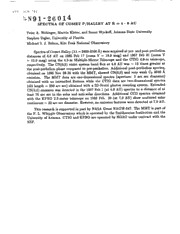
NASA Technical Reports Server (NTRS) 19910016700: Spectra of comet P/Halley at R = 4 - 8 AU PDF
Preview NASA Technical Reports Server (NTRS) 19910016700: Spectra of comet P/Halley at R = 4 - 8 AU
2:34 AC>I ' 91 i':-N 9 1 - 26 014 SPECTRA OF COMET P/HALLEY AT R -- 4 - 8 AU Peter A. Wehinger, Marvin Kleine, and Susan Wyckoff, Arizona State University Stephen Tegler, University of Florida Michael S. J. Belton, Kitt Peak National Observatory Spectra of Comet Halley ()_ = 3400-6500 ._) were acquired at pre- and post-perihelion distances of 4.8 AU on 1985 Feb 17 (coma V = 18.9 mag) and 1987 Feb 01 (coma V = 15.9 mag) using the 4.5-m Multiple-Mirror Telescope and the CTIO 4.0-m telescope, respectively. The CN(0,0) violet system band flux at 4.8 AU was ,-_ 15 times greater at the post-perhelion phase compared to pre-perihelion. Additional post-perihelion spectra, obtained on 1986 Nov 28-30 with the MMT, showed CN(0,0) and very weak C3 4040/_ emission. The MMT data are one-dimensional spectra (aperture: 5 arc sec diameter) obtained with an intensified Reticon while the CTIO data are two-dimensional spectra (slit length -- 280 arc sec) obtained with a 2D-Frutti photon counting system. Extended CN(0,0) emission was detected in the 1987 Feb 1 (at 4.8 AU) spectra to a distance of at least 70 arc sec in the solar and anti-solar directions. Additional CCD spectra obtained with the KPNO 2.2-meter telescope on 1988 Feb. 20 (at 7.9 AU) show scattered solar continuum -_ 32 arc sec diameter. However, no emission features were detected at 7.9 AU. This research is supported in part by NASA Grant NAGW-547. The MMT is part of the F. L. Whipple Observatory which is operated by the Smithsouian Institution and the University of Arizona. CTIO and KPNO are operated by NOAO under contract with the NSF.
